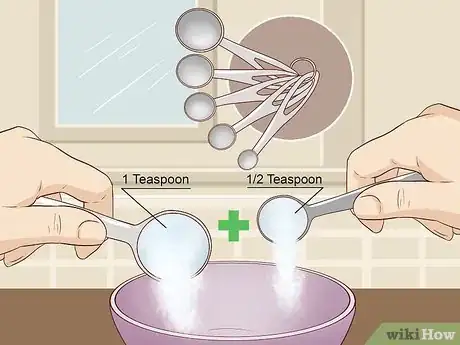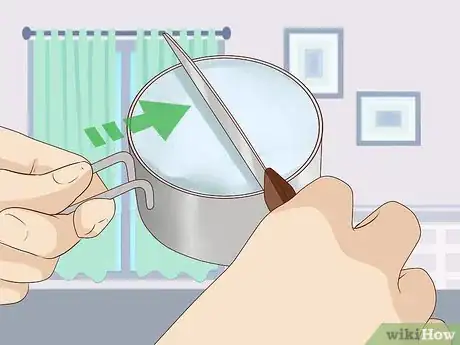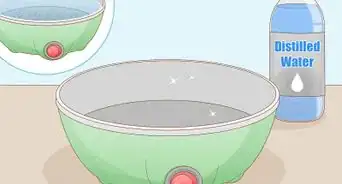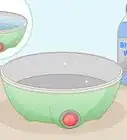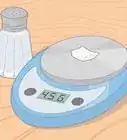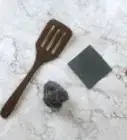This article was co-authored by Jessica Banh. Jessica Banh is a Pastry Chef and the Owner of Fancy Flavors in San Jose, California. With over 12 years of technical experience, Jessica has expertise in a wide variety of pastry techniques and has a focus on macarons. Her work has been featured in The SF Chronicle, The Mercury News, and Good Morning America. She received her training from The Professional Culinary Institute.
This article has been viewed 654,265 times.
Many recipes require measuring cups and spoons so you can include precise amounts of various ingredients. These are quick and easy to use once you know the basic abbreviations, terminology, and techniques. Purchase measuring cups and spoons from a cooking store or supermarket. Once you are used to the different measurements, using the measuring cups and spoons will allow you to quickly and accurately measure your ingredients.
Things You Should Know
- 16 tablespoons is equal to 1 cup.
- 1 small spoon (like the kind used to stir coffee or tea) is equal to 1 teaspoon.
- 1 large spoon (like the kind used for cereal) is equal to 1 tablespoon.
Steps
Measuring with Spoons
-
1Understand the different abbreviations for tablespoons and teaspoons. Many recipes abbreviate measurements to make the text quicker and easier to read. However, if you’re not used to the abbreviations, they can be confusing. If you don’t know understand a measurement, use the information below or search online for the meaning of the abbreviation.[1]
- Tbsp / T = tablespoon
- Tsp / t = teaspoon
-
2Distinguish between a heaped, rounded, and scant spoon. Pile as many dry goods as you can on the spoon to achieve a heaped spoon. Create a rounded hump on top of the spoon to achieve a rounded spoon. Fill the spoon just below the brim to make a scant spoon.[2]
- These measurements are generally used for dry goods. Liquid measurements are always a level spoon.
Advertisement -
3Use a combination of spoons if necessary. Most measuring spoons sets will come with ¼ tsp, ½ tsp, ¾ tsp, 1 tsp, and 1 tbsp. So, for instance, if a recipe asks for 1 1/2 teaspoons, measure 1 teaspoon into the bowl and then add 1/2 teaspoon. [3]
Using Cups
-
1Use dry cups for dry goods and wet cups for measuring liquids. Dry measuring cups are designed to be filled to the top of the cup, whereas wet cups have a measuring line below the brim of the cup. This helps to prevent the liquids from spilling over the edge of the cup when they are transferred to the bowl. Fill each type of cup to their unique measuring line. Check the bottom of the measuring cup for a label if you are unsure if you have a wet or dry measuring cup.[4]
- Place the cup on a flat surface when measuring liquids to ensure an accurate measurement.
- If you are using a jug with cup lines, use this for both wet and dry ingredients. Pour the liquid so that the bottom of the meniscus is at the measuring line.
- Cups are often abbreviated as "C" and most measuring cup sets will contain ¼ C, ⅓ C, ½ C, and 1 C.
- Note that a US cup is 240 mL, whereas a UK cup is 250 mL. If your recipe is written in America, assume that it is a US cup. It is safe to presume that recipes written in Europe and the rest of the world use UK cup measurements.[5]
-
2Push the ingredients down if the recipe requires a packed cup. Use the back of a spoon to push the dry goods down into the cup. Add more dry goods into the cup and press them down once again. Continue to repeat this process until the cup can’t hold any more dry goods.[6]
- This measurement is often used for brown sugar.
- If the recipe doesn’t say that the cup should be packed, do not tap, press, or shake dry goods.
-
3Achieve a level or regular cup by scraping a knife over the top of the cup. If the recipe asks for a regular cup or a level cup, this indicates that you need to sweep off any dry goods that sit above the cup. Hold the cup over the bag of dry goods, so that any excess falls back into the bag.[7]
Community Q&A
-
QuestionWhat is 1/8 of a teaspoon?
 Community AnswerLess than a pinch. It is harder to find a set of measuring spoons that include a 1/8 teaspoon, so use the 1/4 teaspoon and fill it only halfway.
Community AnswerLess than a pinch. It is harder to find a set of measuring spoons that include a 1/8 teaspoon, so use the 1/4 teaspoon and fill it only halfway. -
QuestionWhat utensils do I use to measure rice?
 OllieoxenfreeCommunity AnswerUse a dry measuring cup to measure rice.
OllieoxenfreeCommunity AnswerUse a dry measuring cup to measure rice. -
QuestionHow many spoons is 30 grams?
 Lori MillerCommunity AnswerA gram is a weight measure, whereas a teaspoon or tablespoon is a volume measure. You'll have to weigh your ingredient.
Lori MillerCommunity AnswerA gram is a weight measure, whereas a teaspoon or tablespoon is a volume measure. You'll have to weigh your ingredient.
Warnings
- Accuracy in baking is paramount, since everything is a fine balance of moisture and fat. Due to that, measurements in grams are usually recommended for baking.⧼thumbs_response⧽
References
- ↑ https://www.dummies.com/food-drink/recipes/measurement-abbreviations-and-conversions/
- ↑ http://www.hintsandthings.co.uk/kitchen/measures.htm
- ↑ http://www.hintsandthings.co.uk/kitchen/measures.htm
- ↑ http://joythebaker.com/2013/11/baking-101-im-still-a-baker-even-though-i-use-measuring-cups-not-a-kitchen-scale/
- ↑ https://www.omnicalculator.com/food/grams-to-cups
- ↑ https://www.thekitchn.com/baking-matters-what-is-packed-119443
- ↑ http://joythebaker.com/2013/11/baking-101-im-still-a-baker-even-though-i-use-measuring-cups-not-a-kitchen-scale/
- ↑ http://www.hintsandthings.co.uk/kitchen/measures.htm
About This Article
To use a measuring spoon, fill the spoon to the brim for both liquid and dry ingredients, unless the recipe says otherwise. If you're using a spoon for a dry ingredient, make sure you level off the ingredient by scraping a knife across the spoon. To use measuring cups, use dry cups for dry ingredients and wet cups for wet ingredients. For most dry ingredients, you should scrape a knife over the top of the cup to level off the ingredient inside. If a recipe calls for a packed cup, press the ingredients down in the cup with the back of a spoon. To learn how to distinguish between a heaped, rounded, and scant spoon, read on!


